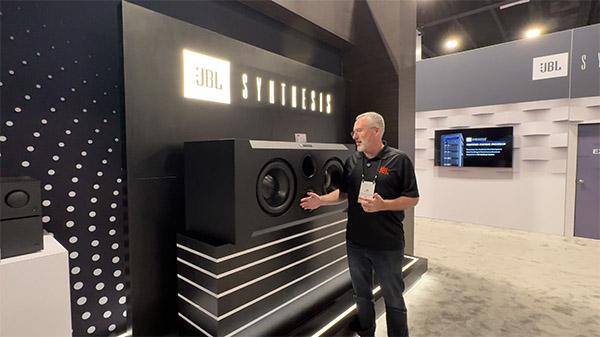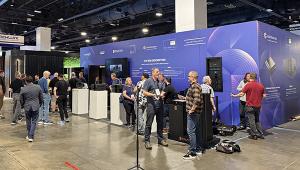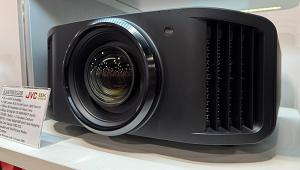Wish they would have indicated when they will be replacing the Revel Performa series.
Harman at CEDIA 2024: JBL Synthesis, JBL MA Series and Stage 2, Arcam, Revel

Join us as Jim walks through the setups, detailing how these products cater to everyone from entry-level music lovers to audiophiles and home theater enthusiasts.
Transcript:
Mark Henninger: Hey, this is Mark from Sound & Vision, and I'm here with Jim Garrett at CEDIA 2024 in Denver, and I am here in the Harman booth, and we are going to check out JBL Synthesis, some regular JBL stuff, and also some Arcam gear.
Jim Garrett: Absolutely!
MH: Take us through it.
JG: So we had our recent launch of the JBL MA Series Modern Audio AVRs and our Stage 2 Series loudspeakers. You were a lucky guest at our launch event there in Hollywood. So we brought that here to CEDIA so we could showcase what we can do and our scalability for our system.
Of course, everyone knows what we can do with Synthesis, and we can scale from small to very massive systems there, but we wanted to really showcase what we can do to bring people out of, let's say, a soundbar.
So if they're coming into component audio for their first time, these are great products to build a system out of. We've got a couple of different systems we're showcasing here.
This one is what we call the soundbar alternative, and let me turn down the volume on it so we're not blasting you out here. We're showcasing a 5.1.2 system. We're using the middle model of our AVRs here, the MA710. We've got a small pair of floor standers.
We're using our 240H, which is a dual-purpose speaker. We're showing it right now on the front as an elevation speaker for Atmos. That's the “dot two” at the end of the system. And then we're using them for surrounds on the back of the wall. So instead of a bookshelf or a floor stander in the back, we've got another pair of these that are mounted here on the rear wall, and we have two crossover networks in this speaker. So you can flip the switch on it, configure it to work as a surround like this, or configure it to work as an Atmos elevation speaker as we're showing on the front. So that's a cool little system here that's about $3,500 price point.
We've got a PlayStation shown here as a source with it, Kaleidescape, of course, and then we're showing the new Samsung short throw projector. I'd be remiss if I didn't mention that to them as well, 120-inch screen. So again, for our audio system in here, the MAs and the Stage 2 loudspeakers, it's about a $3,500 system. We can start you as low as about $1,700 for a 5.1 system with bookshelf speakers and a single sub and our entry-level AVR.
And then we'll take a walk over to the next room and I'll show you where we can go up to for more of what we call like a “performance player” type of system. In the family, we've got HP models and the AVRs that are the two premium products that are in here, and they're more kind of CI-focused, they've got a more advanced feature set on them.
I'll show you in what we've got in this room… I'll take you in here and we'll show you a larger system. This is configured as 7.2.2. You can see in here, we've got the AVR set in stealth mode. Right now, it's got a big, beautiful, full-color display on the front. When you're streaming audio, it's great. When you're in a theater, I don't want that huge display on, so we put it in stealth mode. So it'll turn off on there and just leaves the LED underglow. In here, this is the flagship AVR that we're using, the MA9100. Bigger floor standers we're using in here, the dual 8-inch, the 280Fs, center channel. We've actually got a pair of 12-inch subs at the front of the room.
And then the rest of the system in here is part of the Stage 2 architectural. So we've got 280 CSAs. This is an angled in-ceiling speaker, we're using those for height channels. And then a 250WL, that's a dual 5.25-inch. There's a set on the side and a set on the rear. So now we've got complete custom solution for the sides and the top channels and the rears, so if you want to build those in, you can mix and match.
And it's all the same driver technology, same HDI horns, same 1-inch aluminum dome tweeters, same woofer motors and technologies that we use in the box products. So it's a total mix and match solution for that.
This is being shown in the espresso finish. So obviously in a darkened room here, you saw the latte finish in the other one, a little brighter, a little white. The look that you have on here today, perfect match for you. But in here where we wanted a darker system, we're showing the Espresso finish and the black translucent on the AVR so that these products disappear into a darker environment.
Outside of the room, we've got the displays again. There's the full Stage 2 series that we have in here, two floors, two books. There are two subwoofers, only one here. The other is with our friends at UPS, should be here hopefully tomorrow. Same with the missing center channel there. And then the 240H, which again is our dual purpose Atmos speaker.
So if we come around this side on it, we can shift gears. We can talk about what we do with Arcam. On the AV side, we're showing the AV41 16-channel processor. That's the PA720, which is a 7-channel G-Class amplifier. In this case, we're showing a 3.1 system with Revel speakers.
These are the new (Revel) beryllium in-walls that we just introduced last year. This is the middle model, the 226Be. We're showing them left and right stereo for music, but we've got a third one in a horizontal position as a center channel. We've got a matching 10-inch sub, the B110v2. So we're showing a 3.1 system there. And then the rest of this is a selection of what we do with the Revel in-wall and in-ceiling products from the 2-series, 3-series, 5-series, 7-series, and up to beryllium.
If we want to keep talking about what we do with Arcam, Radia Series has been something new that we've completely redone the hi-fi portion of the range. We did our first phase of products, five models, three integrated amps, two digital sources; we did those at our launch event in London in 2023. At Munich this year, we introduced the second phase of the products, which are products with intelligent streaming built into them. So we've got three products, and they're a dedicated streamer as a step up over the phase one product, and then two more integrated amplifiers.
This is the SA35 that's being shown here. This is a G-Class integrated amplifier, phono stage, high-res DAC in it, wired and wireless streaming capability. We've got Chromecast, we've got AirPlay, Spotify Connect, Tidal Connect. It's a Roon Endpoint.
You can see it's got a big, beautiful, full-color display on the front. When you're streaming, you've got album art, metadata, everything on that. G-Class power, phono stage, two-way Bluetooth on it.
We've actually taken a little bit of time here. If you catch it in the video there, it mentions Bluetooth 5.2. We've actually upgraded to 5.4, so we get Auracast capability on it, which is a really cool thing to have in it. And again, that two-way function. So you could use a mobile device if you wanted as a source, or if you wanted to do some private listening with Bluetooth headphones, you could do that as well. That's the SA35, $3,500 streaming integrated amplifier.
Here's a step up from that, SA45… that is our empty pedestal, again, stuck with UPS. That's the way trade shows go. And then we have all of the Phase 1 products that are here as well.
From that, we'll take you around to JBL Synthesis as we're talking home theater products. Our big demonstration theater here at the show this year, we have two JBL Synthesis systems in there, again, to showcase how we can scale from a small to a large system.
We can move from the JBL systems here, to the modern audio products that we talked about. The cool thing about it is it's a single-brand solution. So JBL AVR, JBL loudspeakers from a brand that people know and trust, they likely had that from their portables, from their headphones, from their soundbar, so you're going to move into that.
But it makes it very easy, so you know the components were designed to work together. And that's definitely what we do here in Synthesis, everything designed, engineered, calibrated to work as a system.
So… in our big showcase theater here, we've got a smaller system based off the Synthesis AVR, and we're using our in-wall speakers and a 7.4.4 channel system. And then as you stay in your seat, you'll get to hear the flagship system. We're using our reference SCL-1, SSW-1 subwoofer.
And you really got to get a sense for the scale of these products. I'm about 6 foot 1, so if you get an idea how big of a product this is, no, it's not an enlarged model here for the show. This is a real one.
We have two of these in the front of the system in there, and we have two of our in-wall subs in the back. And then this is the LCR. This is the SCL-1, which is our flagship. Dual 3-inch compression driver, dual 12-inch woofers, complete custom capability. You can do active outboard crossover, single wire, bi-wire, whatever you need.
And then we're showing here the products you need to drive these. We've got new amplifiers. We've got SDA-8300, SDA-4750, new products being shown here for the first time at CEDIA! These will be shipping in the first quarter of next year. Very advanced amplifiers, Class D, super high power, 4x750, 8x300 on this one.
Advanced DSP gives us loudspeaker tuning, compressor, limiter, anything that you want to do, anechoic EQs on them. They are Dante-ready. We've got XLR inputs, binding post outputs on them, ventilation side to side, so they're quieter in a rack. And again, our power on these was designed to drive our speakers. So this is 4x750, but we can bridge it to 2x2500. This one's 8x300. So now these become the core of our electronics range for Synthesis, and you can match them with our processors, our AVRs, all the way up to the 32-channel SDP-75.
Outside of that, the rest of the loudspeakers are here on display, so you can see what we can offer from a JBL Synthesis solution.
- Log in or register to post comments


It was a really helpful and very informative blog. Players are need to collect notes while navigating a complicated network of rooms and halls in order to finish baldi's basics.

Harman's showcase at CEDIA 2024 highlights exciting innovations across JBL Synthesis, Arcam, and Monkey Mart Game more, catering to all levels from casual listeners to audiophiles. The versatile MA Series AVRs, Stage 2 speakers, and scalable solutions redefine home audio possibilities!

Harman's presence at CEDIA reflects its diverse portfolio, catering to various audiences—from audiophiles to installers. The focus on JBL's versatility, Arcam's innovation, and Revel's premium quality demonstrates the company’s leadership in the audio space. this Crises managment press release reflects our dedication to resolving the issue effectively. We are working tirelessly to regain the confidence of our business.

If you love Japan, you can go to My Little Japan, an online store to buy Japan related products.
















































